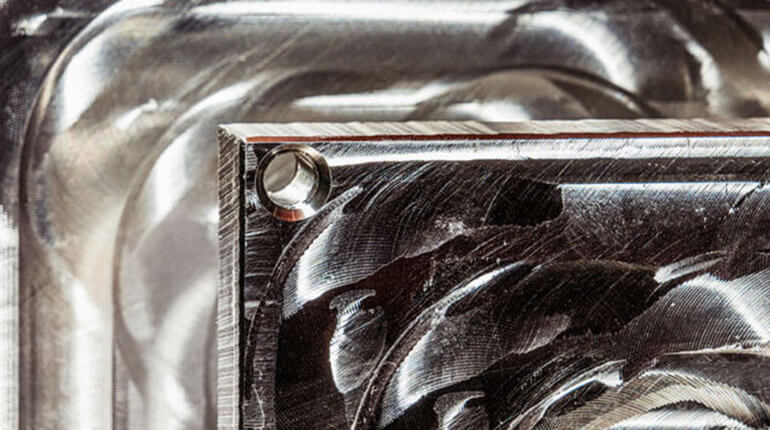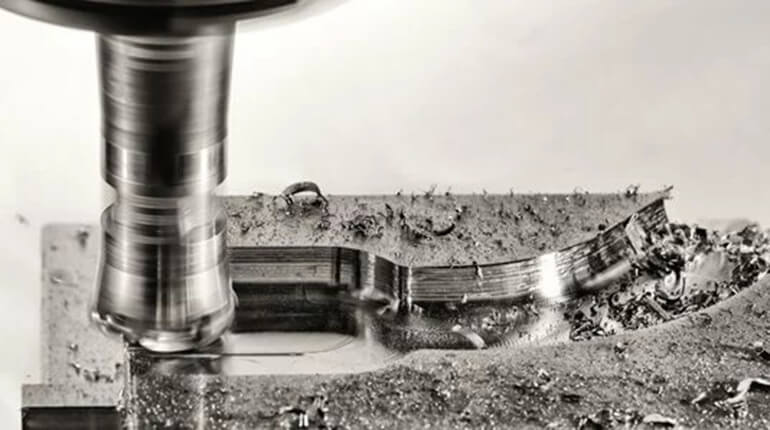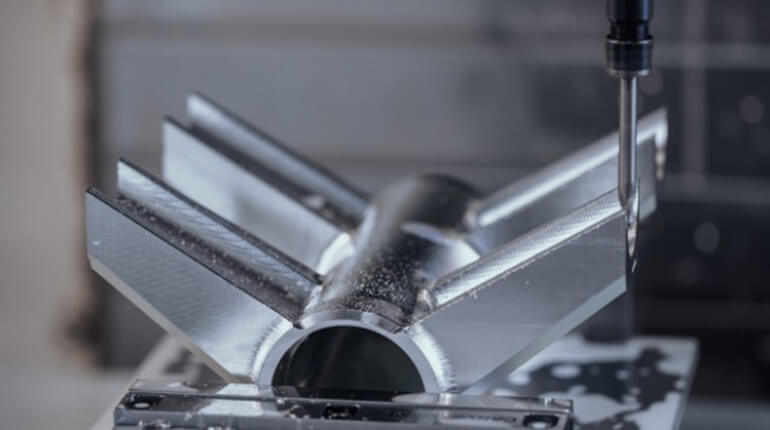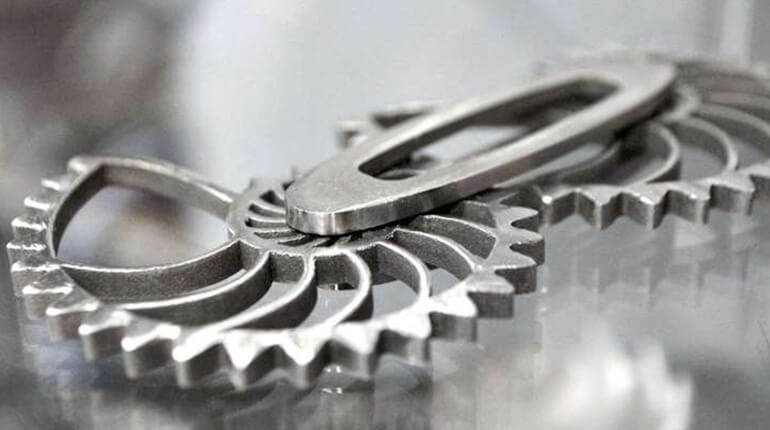
Key Benefits of 5-Axis CNC Machining Titanium
Machining titanium presents unique challenges for many industries. We explore the key benefits of 5-axis CNC machining titanium to overcome these hurdles.
This guide covers how 5-axis technology improves precision, tool life, and efficiency. Discover how it unlocks new possibilities for your most complex titanium parts.
What is 5-Axis CNC Machining?
5-axis CNC machining is an advanced manufacturing process. It uses a cutting tool that moves on five different axes.
This allows the tool to approach a workpiece from any direction.
These axes are the X, Y, and Z linear axes. They are combined with two rotational axes (A and B, or A and C). This simultaneous movement enables the creation of highly complex shapes.
How 5-Axis Differs from 3-Axis
Traditional 3-axis machines move the tool along X, Y, and Z. The tool's orientation is fixed.
To machine different faces, you must manually rotate and re-clamp the part. This process is called re-fixturing.
5-axis machines eliminate most of this. They tilt the tool or the part itself. This allows for machining complex contours in a single setup.
The Unique Challenge of Machining Titanium

Titanium is a highly sought-after material. It offers incredible strength-to-weight ratios. It also has excellent corrosion resistance.
However, it is notoriously difficult to machine. This challenge impacts cost, quality, and lead times.
Understanding Titanium's Properties
Titanium has very low thermal conductivity. Heat does not transfer to the chip effectively. Instead, high heat concentrates on the cutting tool's edge.
The material is also highly reactive. It can chemically bond (gall) to the tool surface at high temperatures.
It also has a tendency to work-harden. This makes the next cut even more difficult.
Common Issues: Heat, Tool Wear, and Galling
These properties lead to several problems:
- Excessive Heat: This quickly degrades the cutting tool. It can also cause thermal distortion in the part.
- Rapid Tool Wear: Tools break down fast. This increases tooling costs and machine downtime.
- Galling: Material welds to the tool. This ruins the part's surface finish. It can also lead to catastrophic tool failure.
- Chatter (Vibration): Titanium's properties can cause tool vibration. This results in poor accuracy and finish.
7 Key Benefits of 5-Axis Titanium Machining

1. Single-Setup Part Complexity
5-axis machines can process five sides of a part at once. This is often called "done-in-one" machining.
You can create complex geometries, like blisks or impellers. This is impossible on a 3-axis machine without many complex setups.
2. Improved Accuracy and Precision
Human error is a major risk in machining. Most errors happen during setup changes.
By machining a part in one setup, you eliminate this risk. The part is not moved. This ensures all features are perfectly aligned. This leads to higher dimensional accuracy and tighter tolerances.
3. Better Tool Life and Cutting Angles
This is a vital benefit for titanium.
5-axis systems can tilt the tool. This maintains an optimal cutting angle. It ensures a consistent chip load. This helps manage heat generation.
You can also use shorter, more rigid tools. Shorter tools vibrate less (reduce chatter). Less vibration and better heat control directly extend tool life. This lowers overall cost.
4. Superior Surface Finish Quality
The ability to tilt the tool creates better finishes.
The side of the cutter can be used, not just the tip. This is called "swarf milling."
This creates a smoother, continuous surface. It avoids the "scallop" marks left by 3-axis ball-nose cutters. You can often skip secondary finishing steps, saving time.
5. Reduced Setup and Fixturing Time
On a 3-axis machine, complex parts need custom fixtures. Creating these fixtures takes time and money.
Each new setup also requires operator time. The machine sits idle during these changes.
5-axis machining minimizes or removes these extra steps. This drastically shortens total lead times.
6. Faster Material Removal Rates
While cutting speeds for titanium must be controlled, 5-axis is still faster.
The machine can use advanced toolpaths, like trochoidal milling. It maintains a constant tool engagement. This allows for deeper, more reliable cuts.
This removes more material in less time compared to shallow 3-axis passes.
7. Access to Difficult-to-Reach Areas
5-axis machines can angle the tool head. This allows it to reach deep into pockets or machine undercuts.
On a 3-axis machine, these features are often impossible. They would require very long, unstable tools. Or, they would require splitting the part into multiple pieces.
5-Axis vs. 3-Axis for Titanium Parts
The choice depends on your part's complexity.
For simple, flat titanium plates, 3-axis machining may be sufficient. However, 3-axis struggles with titanium's challenges. It leads to more tool wear and slower cycle times.
For any part with complex curves, angled holes, or multiple faces, 5-axis is superior.
The 5-axis benefits in tool life and accuracy often justify the cost. It provides a lower total part cost despite higher machine rates.
Applications for 5-Axis Titanium Parts
The unique benefits of this process are vital for specific industries.
Aerospace and Defense Components
This is the largest market.
Parts include: landing gear components, engine blisks (bladed disks), and structural brackets. These parts must be light and strong. They must also withstand extreme temperatures.
5-axis machining is the only way to produce these complex "monolithic" designs.
Medical Implants and Surgical Tools
Titanium is biocompatible. The human body does not reject it.
This makes it perfect for medical implants. Examples are spinal implants, hip joints, and bone plates. These parts have organic, complex shapes. 5-axis machines excel at creating them.
Surgical tools also use titanium for their light weight and strength.
High-Performance Automotive
In motorsports, every gram matters.
Titanium is used for engine components like valves and connecting rods. It is also used for exhaust systems and suspension parts.
5-axis machining provides the speed and precision needed for these applications.
Standard Machining's 5-Axis Titanium Expertise
Machining titanium is not easy. It requires more than just a 5-axis machine.
It demands a deep understanding of the material. It needs correct tooling, software, and process control.
At Standard Machining, we specialize in this work. Our team has extensive experience. We optimize every step for titanium parts. We ensure your components meet the highest standards of quality and precision.
Conclusion: Maximizing Titanium's Potential
5-axis CNC machining transforms titanium manufacturing. It enables complex parts, improves accuracy, and extends tool life. This process unlocks the true potential of this advanced material.
Do you have a complex titanium part? Contact Standard Machining today. Let our 5-axis experts quote your project and deliver the precision you need.
FAQs: 5-Axis Titanium Machining
What is the main challenge of machining titanium?
The primary challenge is poor thermal conductivity. Titanium does not absorb heat well. This concentrates extreme heat at the tool's cutting edge. This high heat causes rapid tool wear, galling, and work-hardening.
How exactly does 5-axis machining reduce tool wear?
It reduces wear in two ways. First, it allows for shorter, more rigid tools. Shorter tools vibrate less (reduce chatter), which is a key cause of tool chipping. Second, it tilts the tool. This allows for optimal cutting angles that manage chip load and heat generation more effectively.
Is 5-axis machining more expensive than 3-axis for titanium?
The hourly rate for a 5-axis machine is higher. However, the total part cost is often lower. This is because 5-axis eliminates costly custom fixtures. It also reduces setup time and manual labor. It produces less scrap and provides better tool life, saving money on tooling and materials.
Can all 5-axis machines handle titanium?
Not necessarily. A machine must have high rigidity and torque to handle titanium's cutting forces. It also requires a high-pressure coolant system to manage heat. Most importantly, it requires experienced programmers, like our team, who understand titanium's specific speeds and feeds.

